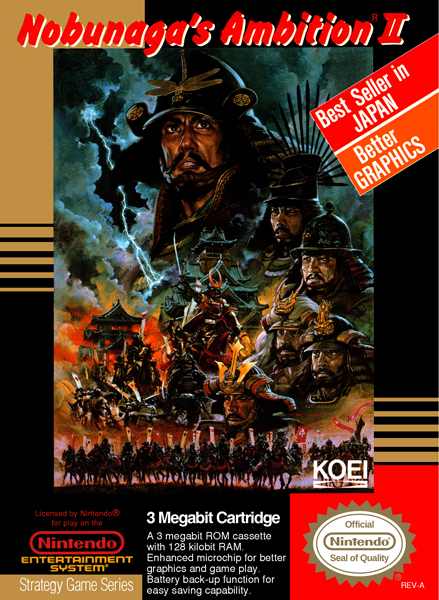
Nobunaga’s Ambition II
System: NES
Release Date: April 1991
Developer: Koei
Publisher: Koei
Genre: Strategy
Take conquest back to feudal Japan in Nobunaga’s Ambition II! Koei has given us a number of strategy games on the NES already and this is our first sequel. This is such an upgrade from all the Koei games we’ve come across. I feel Kou Shibusawa has been doing a great job iterating his ideas throughout the different series. Watching my old videos, I see this as the next step, instead of another lateral movement. Choose from the early Warlord Rivalry or the much later Nobunaga’s Ambition scenario.
I started with a random fief and my daimyo died of old age. I then had a tough time. You have stats to roll when you begin and after another false start, I just decided to play as Nobunaga and had a much more entertaining time learning the ropes. After choosing your fief, you are placed in town with a bunch of things you can do. The first thing you should do is check out your samurai. These men are the ones who do your work. Samurai have two important stats to keep track of, Politics and War. Politics determines the returns you get from building up your fief. War dictates how well they do in army battles. The higher the number on both of these, the better. Instead of being stuck to one action per turn, you get multiple actions per turn based on each samurai’s body points. I did find myself checking my samurai list a lot because you don’t always see their politics stat and you don’t want to waste Body Points or gold.
Towns can be built up in two main ways. September is your rice harvest that can be built up by clearing land, but it’s important to control for floods, as well. March is gold collection, which you increase by expanding the town. It is important to increase the Land Value and Trade statistics to make each town useful. You also recruit soldiers based off the population of the town, but this decreases support. Improving the town increases support, so use it to fend off uprisings! The market allows you to buy and sell food at the going rate, which means keep an eye out for arbitrage opportunities. You can also buy arms to improve your army. Another way to make your troops stronger is by training them in the War menu. You can use well trained armies to boost up weaker ones quickly. There are also Diplomacy and Spy options that I didn’t really even mess with at all.
The battle system is much more streamlined. I like it a lot more, especially seeing the whole map at once. All the maps are hand crafted to make sense based on the geography of the territory. Units have a maximum of 100 troops and based on the samurai can be infantry, cavalry, or riflemen. The goal is to wipe out, scare off, or starve your enemy. Different unit types have different special attacks. Infantry can ambush on the overworld, injuring enemies who step on their square. Charge is a powerful cavalry attack that will kill any unit it defeats. Riflemen use their rifles to deal more damage than they take. Night time obscures hex spaces not directly adjacent to your units and may be a good time to set up ambushes. Sometimes an obviously outmatched opponent would switch to my team during the battle, which was nice. The AI even tried to trick me in battle once when they were weak, but my fief had little rice. They played keep away with one unit and starved my army.
Conquering other fiefs can give you a lot of new samurai with little to no loyalty, which is another important stat to keep in mind. Hopefully you’ve got some gold on hand to gift to them so they don’t take off. Low loyalty can lead to a samurai being stolen from you. You have to guess how much money to spend when buying samurai loyalty. I felt 70 was about the minimum loyalty I was comfortable with allowing them to have men beneath them. A lot of these new samurai will have low politics and war stats that will be unhelpful to you. Which of them you may appoint as governor of the territory is a hard question to answer. As I think about it, I probably would build up my samurai stats during the mid game at built up towns in the center of my empire. Owari, for example, was surrounded completely by my other fiefs, so was in no danger of being attacked. I could have taken advantage of the incredibly high food output, gold output, and culture to make a new class of super samurai. By the time I realized I needed to move on from this game, it was the summer of ‘68 and I had united most of the center of the map. I think I would have united the country by the time the second scenario is set to begin.
Graphics: 2.0
You spend a lot of time in menus that aren’t hideous. The battleground is streamlined and more pleasant to work with.
Sound: 2.0
There are a number of different music tracks and sound effects. They’re not all great, but they aren’t bad.
Gameplay: 3.0
The menus seemed less clunky to navigate than other games in the lineage and you aren’t stuck making a decision because you accidentally clicked an option.
Difficulty: 3.5
There’s a bit of obfuscation around some of the numbers, but I felt the battles and actions of the AI were much more fair than I expected.
Fun Factor: 4.0
You know what, when I put 11 hours into a game and still want to play more, I have to give it a bunch of praise on the fun factor.
Overall Rating: 2.9
Nobunaga’s Ambition II earns a B. This is an upgrade on the rest of the lineage. I like it a lot and if you like strategy games, you will too.
